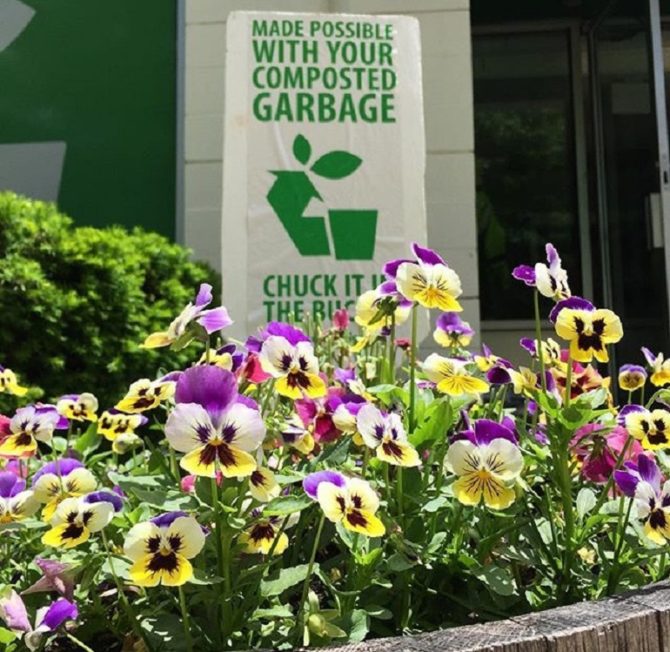The three bites of your burger that you left on your plate. That extra piece of toast that you took but didn’t really want and threw away anyways. The carton of strawberries you let get moldy in the fridge. The expired box of cereal you kept meaning to finish but never did.
All of this contributes to America’s estimated 70 billion pounds of annual food waste, which is simply defined as food that is thrown away or goes uneaten. Globally, the UN Food and Agriculture organization estimates that about one third of food is discarded.

Photo courtesy of eaglebluff.wordpress.com
America wastes 40% of its food. Not only is this practice detrimental to the environment, but it also contributes to the continuation of world hunger. In a 2013 study done by the FAO, the findings showed that food waste is responsible for adding 3.3 billion tons of greenhouse gases into the atmosphere, which might actually be making our food less nutritious.
Socially, the effects on hunger are glaring, and the globe’s current food waste is enough to feed the 870 million currently suffering from hunger. As the population continues to rise, so will food waste, unless actions are taken against it. A report released last year estimated that a reduction in food waste could save $120 to $300 billion globally.
In America, consumers often fail to shop smartly, leading to excess food in pantries that will go uneaten before it is thrown out. Consumers have also become too afraid of using food that has gone past its expiration date.
This wasted food ends up in landfills, where it rots, producing methane, which is then emitted into the atmosphere. If food waste were a country, it would be third highest contributor of greenhouse gases.
Photo courtesy of sustainablog.com
While weaving our way through grocery store aisles, with its rows of boxes and shelves of produce, it becomes easy to see food as a constant abundance. We may pick up a box of pasta or pound of potatoes, not because we want them but because it’s on sale or might use them.
This mentality keeps America as second in global pollution, while 14 percent of U.S. households are still lacking food security. As of September 2015, the USDA has implemented its first set of goals to reduce the nation’s food waste.
After 2013’s U.S. Food Waste Challenge, the administration is now focused on educating consumers to ensure smart shopping and proper food storage. The group shares the message of “reduce, recover, recycle”, which aims to deflate food waste and the number of hungry Americans, along with supplying information on food sustainability.
In South Korea, major gains in eliminating food waste have been made in recent years, marked by the 30 percent reduction of household food waste. Instead of simply educating its citizens, the South Korean government is holding them responsible for the food waste they produce.
Through a swipe-card technology, South Koreans must dispose of their food in special bins, which calculates the amount and cost of the waste. In earlier years, each citizen paid the same amount for disposal, but this new system is more incentive-based.
The nation already had a relatively efficient disposal system, since land is more sparse than in a country like America. Public service announcements and a waste-sorting process are popular with South Koreans, but the government is still looking to cut food waste.

Photo courtesy of @garbagetogarden on Instagram
In America, the efforts to lessen overall food waste is too voluntary. The USDA simply tells citizens that they can “take the pledge” but are offer vague ways to follow through. For example, the “reduce” of the Food Waste Challenge highlights the “what” – “improving product development, storage, shopping/ordering, marketing, labeling, and cooking methods” – but there is no “how” or specific plan of action.
South Korea is more intrusive in its policies, making sure each of its citizens is fully responsible for it contribution to the nation’s food waste totals. The country’s people are becoming more conscious about the waste they are creating and what they can do to eliminate their impact.
Just like mindful eating is advised, mindful usage must become a trend before the U.S. can begin to tackle its food waste phenomenon. Simply buying and using food because its available to us, not because we necessarily need it, is the root of the wasteful culture in America.
A simple pledge won’t ignite a movement that will positively affect the environment and global hunger. By taking a look at what other countries, like South Korea, are doing to inspire their people to make easy changes to their lifestyle can help the U.S. reach its 2030 goal of reducing overall food waste by 50 percent.
Even using foods just past their expiration dates is advisable, especially when thrown into these 15 eco-friendly dishes. Apps like Food Keeper help keep you up to date on when your food will actually go bad, instead of following the often inaccurate labels.
To tackle the food waste issue, it’s all about simply changes, which make food sustainability a less daunting and more achievable one.


